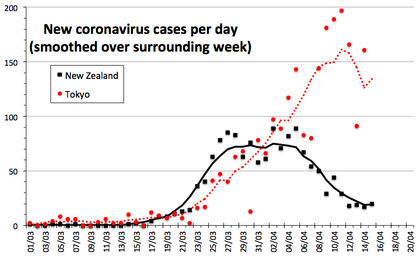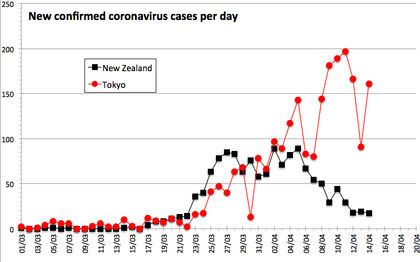Posts by linger
Last ←Newer Page 1 2 3 4 5 Older→ First
-
Hard News: Together Alone, in reply to
I worry that applying that label "Safest place in the world"
is just telling a faultline to bring it on…I also note Japan is unlabelled.
Should I be more worried about that prediction? -
Hard News: Together Alone, in reply to
dystopian authoritarian government
Actually, I thought I was arguing for government by informed consent.
-
Hard News: Together Alone, in reply to
But it won’t be needed to be extended.
Tell that to the virus. It's not running for office. If the aim remains eradication, then some extension could be necessary — but not an indefinite extension. Hence the need for the government to announce, in advance, how they will decide what counts as enough of a "success" to exit lockdown (or in Japan's case, the state of emergency).
Even if they're focused on implications for the election (which I would argue shouldn't be their highest priority), that's the only way their support could stay high if they do have to announce extensions. -
In a democracy, any policy response limiting freedom of movement needs to come with very clear entry and exit criteria. Both NZ and Japan have initially fixed on an arbitrary time limit (four weeks; a month), without trying to set in advance any clear evidence-based criterion for an earlier or later exit. Given that neither policy has yet achieved its stated aim, the lack of such an agreed exit criterion seems an oversight that should be remedied ASAP.
-
Hard News: Together Alone, in reply to

Agreed.
I keep coming back to NZ / Tokyo because it does illustrate a comparison between two different policy responses with different aims: respectively,
(i) rapidly enforced lockdown, with the ambitious goal of eradicating Covid-19 from New Zealand; and
(ii) a gradual increase in restrictions on movement, stopping short of full lockdown, with the less ambitious goal of maintaining the caseload to keep healthcare services from collapsing in Tokyo.
The reported total infections, and rates of infection, were similar up until the end of March.
Admittedly, it’s not a fully controlled comparison in terms of amount of risk to the population, and in terms of the level of statistical reliability available.
In NZ, contact tracing is still mostly working, and most of the existing cases can be connected back to an overseas source, and so the current level of testing is good enough for tracking the spread.
Japan was in a similar position in early March, but that opportunity has since been lost: currently, contract tracing is either not performed, or fails to identify the source, in most new cases, and it can be inferred that the disease is already well-established in the local community.Media coverage of statistics can be woeful at the best of times, but the 24-hour news cycle (and worse, rolling news) seems utterly incompatible with the requirement, now, to evaluate statistics critically, and to take a longer-term interpretation of possible trends, and of research outcomes.
Faced with daily new-case counts, the mainstream media focusses on the day-to-day differences (=the lines connecting each successive data point in the previous graph), when they should be correcting for inherent variability and looking at longer-term trends.
As a small corrective, look at what happens to the same graph if individual daily figures are treated only as individual data points, and the trend line is produced by joining up regression forecasts for each day based on all data for the surrounding week. We can more clearly see the direction of movement over time, but we also get a better idea of the amount of uncertainty in each day’s count (=much higher in the Tokyo data). -
Hard News: Together Alone, in reply to
NO new cases for a week
To clarify: among people not already in quarantine. Level 2 presumes there is no community transmission, so if new cases are limited to those not in community contact (e.g. recent returnees) then that isn’t a barrier to moving out of lockdown, through Level 3, back to Level 2.
Though maybe not back to Level 1. There have been reports from South Korea of some "recovered" cases re-testing as positive. It doesn't seem to happen often, and it is not yet clear if they become contagious again. NZ has so far managed to keep the total case count low enough that it may not be an iaaue, but we don't know yet.
-
Hard News: Together Alone, in reply to

Japan Covid-19 roundup for April 8th-14th
excerpted from the Japan Times, supplemented with figures from Nippon.comApril 8th
State of emergency comes into effect, after being foreshadowed on April 6th and officially announced on April 7th.
Tokyo logs 144 new cases.
(The relatively low daily increases on April 6th (88) & 7th (80) may be explained as reflecting lower access to testing. This raises the worrying prospect that official case counts for areas covered by the state of emergency may, perversely, become (even) less reliable, because reducing movement may also reduce timely access to testing. If new cases stay isolated at home, good; but if as a result they are untested and uncounted, criteria for ending the state of emergency become much less certain. Also worrying is that, of the cases from April 7th, the source of infection remains unknown for 57/80.)April 9th
Tokyo logs 181 new cases.
Prefectural governor for Aichi asks for it to be added into the state of emergency.April 10th
Tokyo logs 189 new cases, reaching 1705 in total. Tokyo bars and nightclubs are ordered to close, opening hours are reduced for restaurants. Cases have now been reported in all prefectures except Iwate.April 11th
Tokyo logs 197 new cases, reaching 1902 in total.April 12th
Tokyo logs 166 new cases: source is probably linked to medical facilities in 87 cases, but remains unclear for 64. Tokyo total reaches 2068, Japan total reaches 7000.
Hokkaido issues a state-of-emergency declaration.
Central government asks businesses to reduce commuting by 70% (but no accountability measures are applied).April 13th
Chiba, Osaka, and Fukuoka prefectures, more directly, ask businesses to shut down.
Government announces plan to distribute two cloth masks to each household starting next week.
Tokyo logs 91 new cases (but this partly reflects lower testing access over the weekend, and these cases include some identifying a hospital-based cluster that could end up being much larger).April 14th
Tokyo logs 161 new cases.
It is getting wearying to have the news report each day’s new case figure as either “a new record high” or “a decrease” rather than acknowledging the simple fact that the numbers for Tokyo (and more generally for Japan) are too uncertain to use as any trend indicator.The NZ figures, while more reliable, also have an inherent uncertainty. Maybe Level 3 restrictions would be enough to maintain the case load, but Tokyo’s experience suggests that, without continued widespread testing, there could be further flareups requiring further lockdowns. It would be safer, and ultimately less disruptive, to extend the current lockdown until there are NO new cases for a week, which would permit a path back through Level 2 to whatever the new normal is.
Stay safe, everyone. -
Speaker: Locked down in Jersey City, in reply to
half your population die
Steady on, the truth is bad enough without having to exaggerate it. In the worst-case scenario, Covid-19 might directly kill 1%. After healthcare services collapse, a similar number would die from being unable to get treatment for other conditions. And in an urban area, there might be further unnecessary deaths for other preventable reasons, such as sewage and waste disposal infrastructure going unserviced. Of course, any preventable death is tragic, and we should all act, calmly, to minimise that outcome. Panic and hyperbole are understandable, but unhelpful.
(Best advice: assume you have it, and act so as not to spread it to others.) -
-
Another week’s Covid-19 roundup from the Japan Times
April 1st
Tottori Prefectural Government has begun using cardboard and plastic sheets as partitions between officials’ desks. Officials explicitly deny that this is an April Fools’ prank.April 2nd
Tokyo logs 97 new cases.April 3rd
Total Covid-19 infections in Japan reach 3113 (excluding the Diamond Princess cluster); Tokyo logs 89 new cases.April 4th
Tokyo Gov. Yuriko Koike continues to urge residents to stay indoors.
Tokyo logs 117 new cases.April 5th
Tokyo logs 143 new cases, putting its total over 1000.
Now “just a matter of time” before Abe declares a state of emergency, says a government source.
Chiba prefecture closes schools until May.April 6th
Total Covid-19 infections in Japan reach 4041 (excluding the Diamond Princess cluster); death toll stands at 108.
Tokyo logs 83 new cases – lower mostly because fewer tests are conducted over the weekend.
The Tokyo Medical Association declares a state of medical emergency.
U.S. Forces Japan announces a public health emergency for the Kanto region until May 5th.
Finally bowing to the inevitable, Abe signals a coming announcement of a state of emergency.April 7th
Prime Minister Shinzo Abe declares a 1-month state of emergency (effective April 8th) covering Tokyo, Osaka, Kanagawa, Saitama, Chiba, Hyogo and Fukuoka prefectures.In the Japanese context, a state of emergency is not an enforced lockdown. Prefectural governments can only issue a “strong request” to stay at home except for essential tasks, though they have more direct power to close schools, childcare, and other public facilities.
Footnote: As of April 5th, there was a striking imbalance in hospitalisations in NZ (13 out of about 1000 cases) and Tokyo (over 800 out of about 1000 cases). Both Tokyo and Osaka are now moving mild and asymptomatic cases out into hotels to keep ICU capacity open (e.g. one hotel in Tokyo will take 100 patients today). On the one hand, this suggests that the bar for hospitalisation has so far been much lower in Japan. Probably it is logistically harder to quarantine Tokyo cases at home. Tokyo hospitals may also be treating some patients from surrounding prefectures. But on the other hand, this large discrepancy in hospitalisations may also mean that some asymptomatic (but still contagious) cases in Japan have gone undetected, which would help explain the current spike in new cases.

